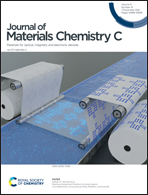Pressure-induced emission enhancement by restricting chemical bond vibration†
Abstract
In this work, we found that the pressure-induced emission enhancement (PIEE) phenomenon can be produced by the restriction of intramolecular chemical bond vibration, which differs from the mechanism of restricting intramolecular motion (RIM). Dibenzo[b,d]thiophene 5,5-dioxide (DBTS) is an aggregation-induced emission enhancement (AIEE) material. In the crystal state of DBTS, the high pressure strengthens intermolecular C–H⋯O![[double bond, length as m-dash]](https://www.rsc.org/images/entities/char_e001.gif) S hydrogen bonds, which greatly restricts the vibration of C–H and S
S hydrogen bonds, which greatly restricts the vibration of C–H and S![[double bond, length as m-dash]](https://www.rsc.org/images/entities/char_e001.gif) O bonds and then rigidifies the molecular skeleton, thereby suppressing the non-radiative process and promoting emission enhancement. In situ high-pressure infrared spectroscopy and angle-dispersive X-ray diffraction analysis combined with reorganization energy and Hirshfeld surface theory calculation provide clear evidence that the restriction of the deformation vibration C–H bonds plays an essential role in PIEE, and S
O bonds and then rigidifies the molecular skeleton, thereby suppressing the non-radiative process and promoting emission enhancement. In situ high-pressure infrared spectroscopy and angle-dispersive X-ray diffraction analysis combined with reorganization energy and Hirshfeld surface theory calculation provide clear evidence that the restriction of the deformation vibration C–H bonds plays an essential role in PIEE, and S![[double bond, length as m-dash]](https://www.rsc.org/images/entities/char_e001.gif) O bonds can act as the powerful controller that enhances intermolecular C–H⋯O
O bonds can act as the powerful controller that enhances intermolecular C–H⋯O![[double bond, length as m-dash]](https://www.rsc.org/images/entities/char_e001.gif) S hydrogen bonds. This study introduces a new AIEE and PIEE fluorophore and provides deep insights into the influence of intermolecular interactions on intramolecular chemical bond vibration and luminescence, which will play an important role in the development of precision optical sensors.
S hydrogen bonds. This study introduces a new AIEE and PIEE fluorophore and provides deep insights into the influence of intermolecular interactions on intramolecular chemical bond vibration and luminescence, which will play an important role in the development of precision optical sensors.



 Please wait while we load your content...
Please wait while we load your content...